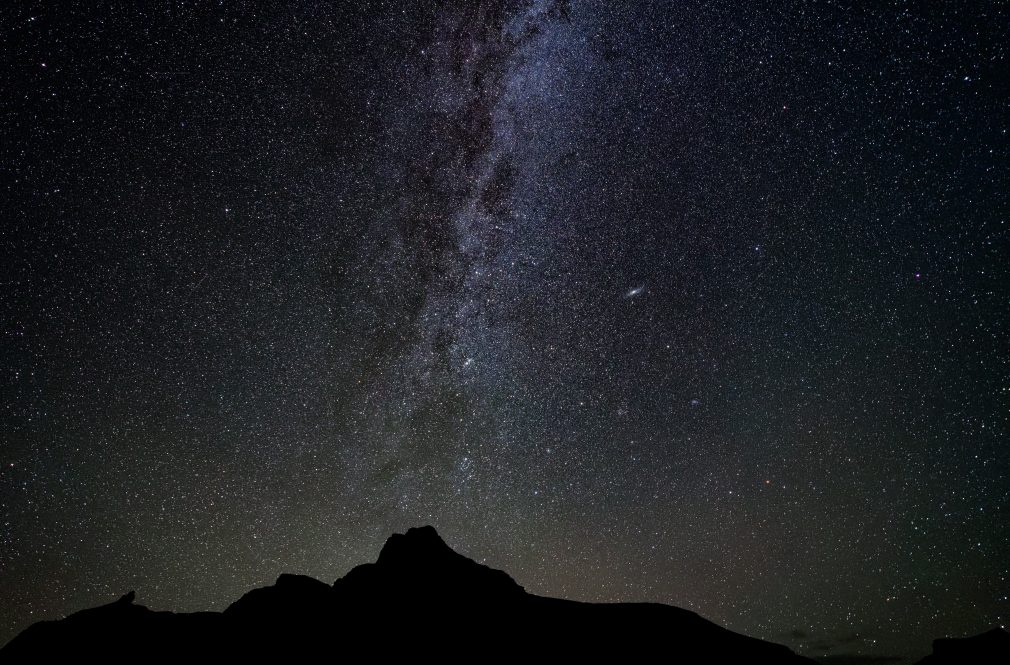Earth – our tiny blue dot in the galaxy – is approximately 26,000 light years away from a fascinating and active region of the Milky Way called the Central Molecular Zone (CMZ). This region holds clues about how stars are born, how energy moves through our galaxy, and maybe even some details about dark matter.
However, analyzing this area is challenging, because we do not have a clear top-down view of the Milky Way. UConn’s Milky Way Laboratory, headed by the Department of Physics Associate Professor Cara Battersby, present their comprehensive analysis and 3-dimensional top-down model of the CMZ in a series of four papers in the Astrophysical Journal.
The CMZ is a region of extremes and complexity, but it is also the only CMZ we can study in detail.
“We like to call the CMZ the way station of the galaxy: between gas that’s flowing in from the disc of the galaxy along dust lanes into the CMZ,” Battersby says. “That gas either remains in the CMZ and orbits around the center of the galaxy, where it sometimes forms stars, or it can travel onwards to the supermassive black hole at the center of the galaxy.”
One question Battersby is interested in learning more about is when the Milky Way’s supermassive black hole, called Sagittarius A, “feeds” or actively accretes material. As a galactic way station, the CMZ controls when and if those materials travel to the black hole. Making direct observations to answer this question is tricky because the CMZ is home to lots of gas, dust, and stars, along with the fact that we are very far away and can only see it from the side.
“To understand how our own CMZ regulates this gas inflow, we need a top-down picture,” Battersby says. “We probably have hundreds of thousands of images of our galactic center, all in this sideways perspective. We can learn everything we want about these clouds, but if you don’t know which ones are flowing toward the black hole or which ones are orbiting, then you can’t really say anything about how the CMZ regulates this gas flow. We can do a better job of modeling the three-dimensional gas distribution.”
In this series of papers, Battersby’s research group takes all available evidence to measure and catalog aspects of the clouds in this region of the galaxy to create the best possible top-down three-dimensional view of the CMZ.
The first step was to compile a comprehensive catalog of structures in the CMZ and to measure their physical and kinematic properties, such as mass, radii, temperature, and velocity dispersion, described in papers one and two.
With these comprehensive catalogs, the next two papers focus on the small-scale structures within the catalog, which are thought to be individual molecular clouds that may be the birthplaces of clusters of stars, says Battersby. The third paper was led by former post-doctoral fellow Daniel Walker and the fourth paper was led by current Ph.D. student Dani Lipman.
The galactic center is very bright and emits light at many wavelengths, therefore, the properties of the molecular clouds give clues about their location within it. The researchers used different approaches to measure and determine which clouds are in front of or behind the galactic center.
“These molecular clouds are places where stars form only when the gas is very dense and very cold, and much of the gas in the galactic center is hot and diffuse,” Battersby says. “These cocoons of cool, dense gas mean that when they’re in front of the galactic center, they absorb the bright light from the galactic center, and they look like shadows. On the other hand, if those clouds are behind the galactic center, then this light passes through, and the clouds don’t block that light at all.”
The researchers developed new techniques to measure how much light is blocked by the molecular clouds with the assumption that if a lot of light is blocked, it is likely that the cloud is in front of the galactic center.
“Papers three and four use two different techniques. Paper three focuses on radio wavelengths of light, and it focuses on the molecular clouds absorbing the radio wavelengths. Paper four focuses on infrared dust extinction and details a careful technique to measure the “shadow” based on the properties of the cloud, thereby quantifying the likelihood that it’s either in front of or behind the Galactic Center,” says Battersby.

Next, the researchers modeled what their data suggested was happening in the CMZ and compared that to existing models of what the galactic center may look like from the top down.
There were three predominant models of what our galactic center may look like, and Battersby says the locations of the molecular clouds the group mapped vary quite a bit across the different existing models. By accounting for the dynamic movements of various clouds, the researchers found existing models lacked this complexity and more work is needed to study the flow of gas in the CMZ.
“Paper three presented a new simple ellipse model that is a slightly better fit than the previous models. Dani Lipman is currently drafting paper five that presents a quantitative best-fit model of the top-down view of our Galaxy’s CMZ, which includes the release of public code so future researchers can continue to improve our top-down model of the CMZ as new data arrives.”
Lipman says that paper five aims to combine any available data to determine the most likely position of a given cloud in front of or behind Sagittarius A*. These positions are then used to find a best fitting top-down model for the CMZ. The model is continually updated and improved as more data becomes available,
“Modern science is wonderfully collaborative, so releasing our code is a huge part of engaging in the community and offering resources to new scientists and students who are eager to join in answering these questions,” says Lipman.
This series of papers is a major step forward in understanding the 3-D structure of our Galaxy’s CMZ and enables researchers, like Battersby’s Milky Way Lab, to start answering pressing questions about our galaxy,
“The CMZ provides ‘close’ access to extreme phenomena seen throughout the Universe, such as an accreting supermassive black hole, and star formation in a highly turbulent environment,” says Battersby. “Knowing the 3-D structure is essential to tracing flows towards the black hole as well as testing theories of star formation in an extreme environment, because you need to know where everything is in this dynamic environment.”
This work is supported by the National Science Foundation through Award Nos. 1816715, 2206510, and CAREER 2145689. Further details, including a narrated guided tour of the CMZ, can be found on the 3-D CMZ project website.



